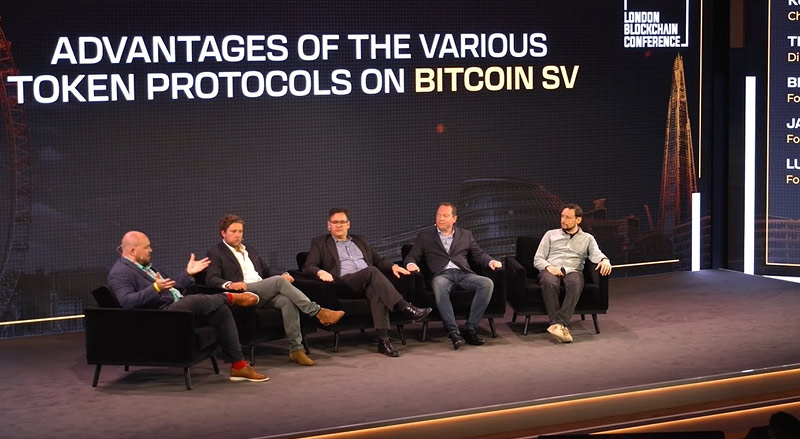A team of experts unpacked the advantages of the various token protocols on the BSV Blockchain at the London Blockchain Conference 2023. This included a discussion on what a token is and how it works. The experts also discussed some of the work their respective teams are doing with tokens and the reasons why they chose certain tokens and implementation methods.
The panel discussion included
- Brendan Lee (Founder and CEO of Elas);
- James Belding (Co-Founder and CEO of Tokenized);
- Luke Rohenaz (Co-Founder and CEO of TonicPow);
- Thomas Giacomo (Head of Product at BSV Blockchain).
What are tokens and token protocols?
The panel discussion began by discussing exactly what a token is and how it works. A token is simply a digital record of ownership on the BSV blockchain that is managed by a smart contract. Specifically, it is a digital ledger entry that records the ownership rights of a certain entity for a given asset and the subsequent changes of ownership over time to the BSV ledger.
Each company has the freedom to create its own token protocol and the BSV Blockchain supports a variety of token protocols to meet every demand.
The token protocols on the BSV Blockchain
The panel also discussed the advantages of the various token protocols on the BSV blockchain.
STAS: The STAS protocol creates smart contract-based tokens and enforces token persistence with optimised minimal code size. STAS tokens as native L1 tokens on the BSV Blockchain protocol are ideal for implementing token or NFT solutions that rely on long-term stability and decentralised management.
1SAT Ordinals: 1Sat Ordinals is a completely FOSS protocol which infuses individual sats with numismatic values at the atomic level of BSV. Each sat can now be inscribed with any arbitrary data; creating unique BSV-native digital artefacts that integrate with all wallets. Inscriptions are as scalable, durable and secure as BSV itself, and 1Sat Ordinals is uniquely powerful among token protocols because of its elegant simplicity.
ELAS Token: Elas uses the Metanet concept to create private, permissioned ledgers for the multi-signature issuance of tokens on the BSV Blockchain. Tokens are issued as UTXOs and can be transacted using any valid Bitcoin script, supporting arbitrarily complex token functionality. Fixed or dynamic Satoshi amounts can be used to allow both fungible and non-fungible tokens. Issuance and transfer signatures are all validated at the Bitcoin consensus level, but Elas token protocol enforcement is governed by Elas infrastructure, tuned for each specific use case.
Tokenized: The Tokenized Protocol is an open-source application layer protocol that utilises the BSV Blockchain for passing, authenticating and storing messages. The protocol focuses on data (aka records) captured from financial, legal, commercial and accounting activities for all types of legal entities and ownership structures. It aims to disrupt modern financial messaging, and EDI, standards (e.g. ISO 20022) with an improved value proposition, and ultimately usher in the smart contract era through a digital transformation of contracts, and the associated instruments and records.
Simple Fabriik Protocol: Simple Fabriik Protocol for tokens is, as the name indicates, a simple protocol developed to add token capabilities to your application. SFP is a permissioned token standard that tracks token transfers with a centralised server to authorise transactions. All SFP tokenised assets can be exchanged directly with paymail. Generally used for NFTs, loyalty, gaming or reward tokens.
Run network: Run is a platform to build apps and tokens on BSV. Developers create applications using interactive objects, called jigs. Jigs allow you to build almost anything you can dream up: Tokens, contracts, artwork, elections, games, digital pets, and more — all run on BSV. Run supports full object-oriented programming and arbitrary code today. Applications like CryptoFights and Duro Dogs have shown the scalable use of the Run network for real-world applications.
